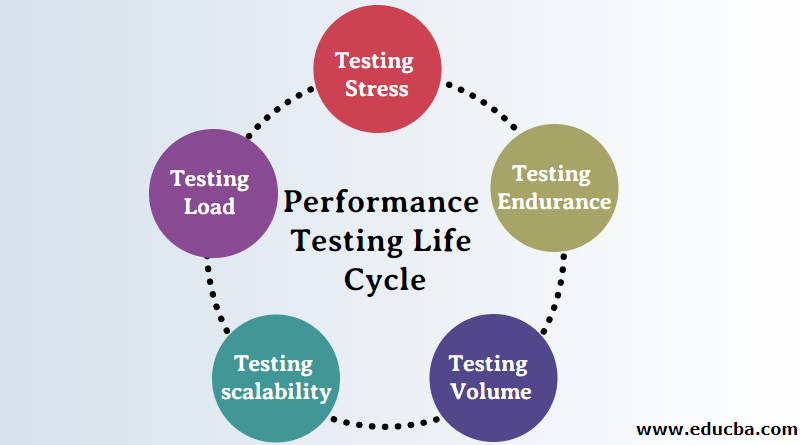Updated March 16, 2023

Overview of Performance Testing Life Cycle
Performance testing is a type of testing for evaluating the non-functional error prone scenarios like the application’s efficiency, the behaviour of the application to act under certain conditions, the volume of data flowing through the application databases/ interfaces, etc. For performance testing, the life cycle starts from analyzing the non-functional areas, test strategy required, testing flow design, and analysis for test results. A few of the various types of performance testing are Testing load, Testing stress, Testing endurance and testing the volume.
What is the requirement for the Performance Testing Life Cycle?
Performance testing was not so crucial and it could be that a tiny portion of the globe used the technology and met the demands of current hardware and software. Now, the situation has changed. Whether the application can manage X user quantities or not is the answer when a start-up begins or launches a website or a mobile app? Whether or not the request is reactive? Even the end customers expect a rapid response. Day by day, the designer has to think of implementation with more tuning that can manage a load of many customers with rapid response. Now, how can the efficiency of implementation be measured? What are the measurements of the results? Which parts and on what basis should participate in performance testing? A method was developed to answer all these questions, split into the number of stages of performance tests. The objective was to establish a smooth, channeled method for achieving the performance test objective.
Types of Performance Testing
The various performance testing types are:
1. Testing Load
It monitors the ability of the application to perform under expected user loads. The aim is to identify performance gaps before the application goes live.
2. Testing Stress
This involves testing a high traffic or data processing application in extreme working loads. The aim is to identify the point of departure for a request.
3. Testing Endurance
The software is designed to ensure that the expected load can be handled for a long period.
4. Testing Volume
Large no. of under volume testing. Data are stored in a database and the overall behavior of the software system is monitored. The aim is to verify the performance of the software application in different volumes.
5. Testing Scalability
Scalability tests are designed to assess the efficiency of the software application in scaling to support a higher user load. It helps to plan additional capabilities for your software. You will now need various kinds of tools that are compatible with your test plan if you want to do any of these tests on your server. Let’s look at some of the important testing tools for performance.
When is the Best Time to Start a Performance Testing Life Cycle?
Performance testing begins in conjunction with the Life Cycle Software Development. Elicitation of NFR is conducted parallel to System Specification Requirement (SRS). let’s look at the various phases of the performance testing life cycle.
1. Educating and Analyzing non-functional requirements
The start and most critical stage of PTLC is the understanding of non-functional requirements.
Tasks
- AUT architecture comprehension
- Identifying and understanding critical situations
- Interface Details Understanding
- Pattern Growth
2. The strategy of Performance Testing
This phase identified how performance testing for the critical scenarios can be approached. During this stage, the following should be addressed. Set up the environment for the and the software.
Activates of Strategy of Performance Testing:
- Prepare and review the testing strategy.
- Scope and out scope definition.
3. Test Design Performance
This phase involves the generation of the script in a specific environment using the identified testing tool. All the improvements to the script and the unit should be tested.
Activities Test Design Performance
- In design Test Performance, we test the Scripting
- Design of measures and transactions
4. Performance Test Result Analysis
This phase involves test engineers who create scenarios based on the defined workload and load the system with the concurrent Users.
Activities of Performance test Result Analysis
- Scenarios are designed
- Execution monitoring
Benefits of Performance Testing Life Cycle
- Validate Features: Performance testing validates the software’s basic characteristics. The performance measurement of the fundamental software features enables company leaders to decide important things about software configuration.
- Measures velocity, precise and stable: This enables you to monitor your software’s critical parts under pressure. This provides important data on how to manage the scalability of the software.
- Stay pleased with your customers: The measurement of applications enables you to monitor the responses of your clients. The benefit is that before your clients you can identify critical problems.
- Identify discrepancies: A buffer for developers before launch is provided by measuring efficiency. Any problems will probably be magnified once released.
- Load capacity and Optimization: Measuring your company’s output can assist your organization handle quantity so that your software can deal with elevated user concentrations.
Now that you understand the benefits of performance testing.
Conclusion
Performance testing is required in software engineering before the commercialization of any software product. It guarantees customer satisfaction and protects an investor from a product failure. So in this article, we have seen what the are stages of Performance Testing Life Cycle are. I hope you’ll find this article helpful.
Recommended Article
This has been a guide to Performance Testing Life Cycle. Here we discuss Introduction to Performance Testing Life Cycle and Different Types Of Performance Testing along with Benefits. You can also go through our other suggested articles to learn more –
